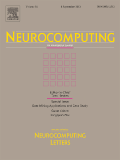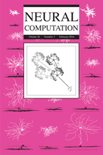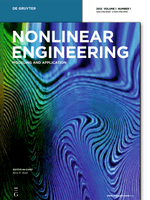
Frontiers in Computational Neuroscience
metrics 2024
Transforming Neuroscience Research through Open Access Collaboration.
Introduction
Frontiers in Computational Neuroscience, published by FRONTIERS MEDIA SA, is a leading journal within the fields of neuroscience and computational biology, dedicated to advancing the understanding of the brain's complex functions through innovative computational methodologies. Since its establishment in 2007, this Open Access journal has provided a platform for researchers around the globe to share their groundbreaking findings, as evidenced by its continual presence in the academic conversation and a strong ranking within Scopus metrics (Rank #12/49 in Neuroscience - Neuroscience (miscellaneous) and Rank #63/97 in Cellular and Molecular Neuroscience). With an esteemed impact factor reflective of its quality and influence, and a commitment to providing freely accessible research, this journal plays a crucial role in fostering collaboration and knowledge dissemination among professionals, researchers, and students alike. Located in the scientific hub of Switzerland, it invites submissions from diverse perspectives, aiming to bridge the gap between computational models and biological insights through rigorous peer-reviewed publications.
Metrics 2024
 -
- 2.10
2.10 2.90
2.90 -
-Metrics History
Rank 2024
IF (Web Of Science)
JCI (Web Of Science)
Quartile History
Similar Journals

NEUROCOMPUTING
Pioneering Research in Neural and Computational FrontiersNEUROCOMPUTING is a premier academic journal published by ELSEVIER, specializing in the interdisciplinary fields of Artificial Intelligence, Cognitive Neuroscience, and Computer Science Applications. With an impressive impact factor and a Q1 ranking in its relevant categories for 2023, NEUROCOMPUTING is recognized as a leader in fostering innovative research and providing a platform for ground-breaking studies. The journal’s scope covers the convergence of neural computation and artificial intelligence, making it essential reading for researchers and professionals seeking to explore the latest advancements and applications in these dynamic fields. For those interested in the cutting-edge intersection of neuroscience and computational techniques, NEUROCOMPUTING offers a wealth of knowledge that significantly contributes to both theoretical and practical advancements. The journal is dedicated to publishing high-quality, peer-reviewed articles and is an invaluable resource for students and established scholars alike, looking to stay at the forefront of research trends.

NEURAL COMPUTATION
Connecting neural science with computational breakthroughs.NEURAL COMPUTATION, published by MIT PRESS, is a leading academic journal that focuses on the interdisciplinary field of neural computing, combining insights from artificial intelligence, cognitive neuroscience, and computational modeling. With an impressive impact factor and consistently high rankings—being positioned in the Q1 category of Arts and Humanities and Q2 in Cognitive Neuroscience—this journal serves as a vital resource for researchers and professionals interested in understanding the complex interactions between neural processes and computational systems. Founded in 1995 and continuing through its converged years until 2024, NEURAL COMPUTATION publishes cutting-edge articles that advance theoretical knowledge and practical applications in both fields. While it does not provide open access, the journal ensures rigorous peer-review processes, making it an essential platform for disseminating significant research findings. With its commitment to fostering innovation and understanding at the intersection of neuroscience and computation, NEURAL COMPUTATION stands out as a cornerstone for academic exploration and discovery.

JOURNAL OF COGNITIVE NEUROSCIENCE
Advancing the frontiers of cognitive understanding.Welcome to the JOURNAL OF COGNITIVE NEUROSCIENCE, a premier publication in the field of cognitive neuroscience, published by the esteemed MIT PRESS. Since its inception in 1989, this journal has been at the forefront of advancing our understanding of the neural mechanisms underlying cognitive processes, boasting an impressive convergence period through 2024. With its Q1 ranking in the 2023 cognitive neuroscience category, it stands out among 115 peers, indicating its critical role in shaping contemporary research. The journal offers a comprehensive array of research articles, reviews, and methodologies aimed at researchers, professionals, and students alike, facilitating the exploration of complex cognitive functions. While not an open-access journal, it provides essential insights and significant contributions to the neuroscience community, making it an invaluable resource for anyone keen on delving into the intricacies of the human brain.

SIAM Journal on Mathematics of Data Science
Transforming Complex Data into Mathematical ClaritySIAM Journal on Mathematics of Data Science is an esteemed publication within the fields of applied mathematics and data science, published by SIAM PUBLICATIONS. This journal serves as a vital platform for researchers and practitioners, dedicated to disseminating high-quality research that addresses complex mathematical problems arising in the context of data science. The journal aims to bridge the gap between rigorous mathematical theory and practical applications, fostering interdisciplinary collaboration among mathematicians, data scientists, and statisticians. With its commitment to excellence, the SIAM Journal on Mathematics of Data Science contributes significantly to advancing the understanding and development of mathematical methodologies that analyze and interpret large datasets effectively. Researchers and professionals will find it an invaluable resource with its comprehensive articles, insightful reviews, and original research papers, which represent the forefront of innovative mathematical approaches in the evolving landscape of data science. For those interested in contributing to this dynamic field, the journal provides an array of access options tailored to diverse audiences.

International Journal of Unconventional Computing
Redefining Computational Boundaries for Tomorrow's ScienceThe International Journal of Unconventional Computing, published by OLD CITY PUBLISHING INC, is a pivotal platform for innovative research within the field of Computational Science. With a significant focus on unconventional computing methods, this journal aims to explore new paradigms and approaches that challenge traditional computational models. Launched in 2008 and running through 2024, it has established itself as a noteworthy publication in its domain, currently categorized in the Q3 quartile for Computer Science (miscellaneous). While it holds a Scopus rank of #143 out of 232 in General Computer Science, the journal continues to attract submissions from a diverse range of scholars—fostering a rich dialogue on cutting-edge developments. As an essential resource for researchers, students, and professionals eager to delve into pioneering computing techniques, this journal invites the global academic community to contribute and engage with its content. Access options vary, promoting flexibility for readers interested in exploring unconventional methodologies in computing.

Nonlinear Engineering - Modeling and Application
Pioneering Research for a Dynamic Engineering LandscapeNonlinear Engineering - Modeling and Application is a premier journal dedicated to advancing the fields of engineering, modeling, and simulation, published by De Gruyter Poland Sp. z o.o. since 2012. With an impressive impact factor reflected in its prestigious rankings—Q2 in Chemical Engineering and Miscellaneous Engineering and Q3 in Computer Networks and Communications—this journal serves as an invaluable resource for researchers and practitioners seeking to explore the intricacies of nonlinear systems and their applications. As an Open Access journal since 2019, it ensures that groundbreaking research is readily available to the global community, fostering collaboration and innovation. Situated at the forefront of its field, Nonlinear Engineering provides high-quality, peer-reviewed articles that contribute to understanding complex phenomena in various engineering disciplines, making it an essential publication for those eager to stay on the cutting edge of technology and research.

Natural Computing
Unlocking Nature's Secrets for Computational AdvancementNatural Computing is a leading peer-reviewed journal published by Springer, focusing on the interdisciplinary study of natural computation methods and their applications across various domains. With an ISSN of 1567-7818 and an E-ISSN of 1572-9796, this journal has established itself as vital in the field of Computer Science Applications, as reflected in its esteemed Q2 quartile ranking and a Scopus rank of #358 among 817 journals, placing it in the 56th percentile. Based in the Netherlands, Natural Computing covers a diverse range of topics, including computational models inspired by natural systems, evolutionary algorithms, and swarm intelligence. Seeking to bridge the gap between theoretical research and practical applications, this journal serves researchers, professionals, and students by providing insights and advancements in the field. With a commitment to fostering innovation, Natural Computing aims to push the boundaries of understanding in computational methods inspired by nature, making it an essential resource for those looking to contribute to and stay updated within this dynamic area.

CLINICAL EEG AND NEUROSCIENCE
Pioneering Research in ElectroencephalographyCLINICAL EEG AND NEUROSCIENCE, published by SAGE Publications Inc, stands as a pivotal journal in the fields of neurology and neuroscience, with a focus on the latest research and advancements in clinical electroencephalography and neurophysiology. Since its inception in 1970, the journal has provided a platform for rigorous scholarly work, offering valuable insights into neurological disorders and EEG technology. With its current categorization in the Q2 and Q3 quartiles across various subfields of medicine and neurology, it ranks prominently in the Scopus database, emphasizing its significance in academic discourse. The journal's commitment to disseminating high-quality research is underscored by its open access options, facilitating broader accessibility to its published findings. For researchers, clinicians, and students alike, CLINICAL EEG AND NEUROSCIENCE remains an essential resource for keeping abreast of the evolving landscape of neurological studies.

NEUROINFORMATICS
Bridging Neuroscience and Information Systems with InsightNEUROINFORMATICS, published by HUMANA PRESS INC, is a distinguished journal in the vibrant field of neuroinformatics, bridging the disciplines of neuroscience and information systems. With an impressive Q1 ranking in Information Systems and strong positioning in both Neuroscience and Software categories, this journal provides a vital platform for the dissemination of research that integrates computational approaches with neurological data, aiming to advance understanding of neural systems and enhance research methodologies. As a key publication from 2003 to 2024, it features original research, review articles, and case studies that are critical for professionals, researchers, and students alike. Its robust rankings underscore its influence and relevance in the academic community, making it an essential read for those dedicated to the intersection of neuroscience and computational science. For the latest insights and developments in this fast-evolving area, NEUROINFORMATICS remains an indispensable resource.

CEREBRAL CORTEX
Pioneering research in cognitive and molecular neuroscience.CEREBRAL CORTEX, published by Oxford University Press Inc, is a premier journal dedicated to advancing the field of neuroscience, specifically focusing on the cellular, molecular, and cognitive aspects of cortical structure and function. With an impressive impact factor that situates it in the top quartile (Q1) of its categories for 2023, this journal holds significant relevance for researchers and professionals interested in the latest discoveries and methodologies in both Cognitive Neuroscience (ranked #31 out of 115) and Cellular and Molecular Neuroscience (ranked #48 out of 97). Operating without an open access model, it ensures rigorous peer review and dissemination of high-quality research from across the globe. Since its inception in 1991, CEREBRAL CORTEX has established itself as a critical platform for educators and inventors, pushing the boundaries of knowledge in understanding brain function and its implications for behavior. Researchers and students alike will find this journal an invaluable resource for both foundational and cutting-edge studies in neuroscience.